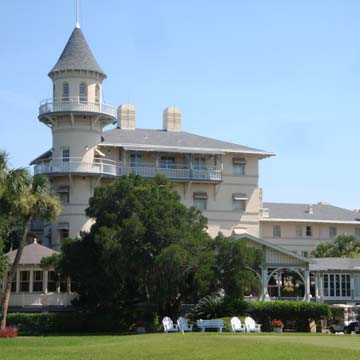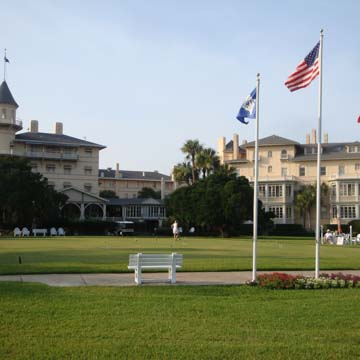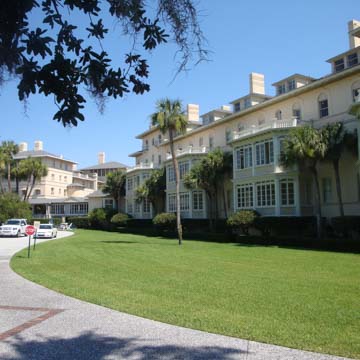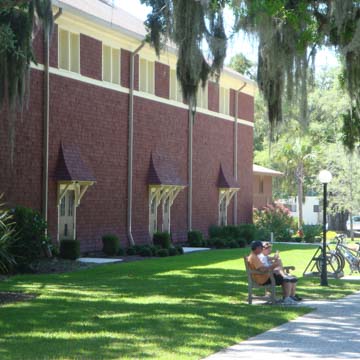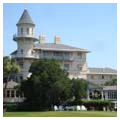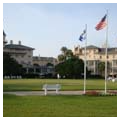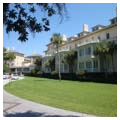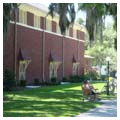You are here
Jekyll Island Club
In the 1880s, John Eugene DuBignon, a descendent of French royalists who had emigrated to America in the late eighteenth century and settled on Jekyll Island, intended to establish a gentlemen’s club on the barrier island. Working with his brother-in-law, Newton Finney, who lived in New York, DuBignon formed a corporation of wealthy northern investors, including J. P. Morgan, William Rockefeller, Vincent Astor, Joseph Pulitzer, James J. Hill, and William Vanderbilt. Many were members of the prestigious Union Club in New York, where Finney was also a member, but some were also from Chicago, including Marshall Field and Wirt Dexter, and others were wealthy industrialists, bankers, and railroad magnates from Philadelphia, Albany, Buffalo, and San Francisco, including such recognizable names as Macy, Goodyear, and Gould. A 1904 issue of Munsey’s Magazine described the Jekyll Island winter retreat as “the richest, the most exclusive, the most inaccessible club in the world.”
The “association of wealthy gentlemen” was publically announced on April 4, 1886. Chicagoans took an early lead in planning the development of the island. Dexter’s building committee selected Charles A. Alexander to design the clubhouse. Ezra McCagg, who had served on the Lincoln Park Commission in Chicago, was chairman of the landscape engineering committee and elected William Shaler Cleveland, second only to Frederick Law Olmsted among leading American landscape architects, to plan the grounds. Alexander’s drawing of the proposed Jekyll Island Clubhouse was published in the January 1887 issue of American Architect and Building News, and depicts a rambling Queen Anne hotel with corner turret and wraparound veranda, bay windows, extended chimneys and an overall asymmetrical design. Handsome interior details included Ionic columns in the dining room, high ceilings (twelve and fifteen feet), oak wainscoting and other intricately detailed woodwork, as well as leaded art glass and ninety-three distinctively detailed fireplaces. Ground was broken in mid-August 1886, and the clubhouse opened for the winter season in January 1888. During the early years, some members required larger accommodations and began to build cottages along the road leading to the clubhouse, taking advantage of sites overlooking the inland water.
High demand of the clubhouse necessitated the construction of a clubhouse annex in 1901. Designed Charles Alling Gifford, the annex maintains a similar scale and details of the main building. Bay windows are large and likely influenced the comparably scaled range of porches fronting the Sans Souci Apartments south of the annex. In 1904, architect Howard Constable designed a shingle-clad Gothic Revival chapel (Faith Chapel) north of the clubhouse, which was established as a nondenominational church although it served a predominantly Episcopalian club membership. In 1929, J. P. Morgan funded construction of a wood-framed indoor tennis court, and throughout his membership contributed to other club improvements, notably the road infrastructure.
The clubhouse thrived, although not without maintenance issues and economic demands that began to wear on even the club’s wealthiest members. Cottages continued to be built during the early century and after World War I but the Great Depression eroded active club participation. During the 1930s membership declined by half, and World War II was the final blow: threats of German submarines off the coast prompted the government to order the evacuation of Jekyll Island. The club’s president hoped to reopen Jekyll Island Clubhouse after the war, but by 1947 Georgia Governor Ellis Arnall, and then his successor Melvin E. Thompson, gave indication that the State of Georgia intended to condemn the island in order to force a sale and turn the island into a state park. Surviving club members objected to no avail. A judge ruled that the state had the authority to take the island by condemnation, compensating owners in the aggregate amount of $675,000, and the club was closed. The Jekyll Island Corporation dissolved, and all previous property owners were forced out by January 1948.
In 1950, the state formed the Jekyll Island Authority for the overall management and stewardship of the island. State attempts to operate the island as a resort ultimately failed, and the clubhouse hotel closed again in 1971. Preservationists made efforts to conserve the clubhouse, cottages, and other landmarks. The Clubhouse was listed on the National Register of Historic Places in 1972, and the full ensemble of buildings (comprising 33 structures on 140 acres) was declared a National Historic Landmark in 1978. Radisson Hotels took over the Clubhouse in 1985, renovated it, and reopened it in 1987. Smith Dalia Architects completed a restoration of the Clubhouse in 2001, as part of a masterplan for the Jekyll Island Historic District. Today the former Clubhouse operates as the luxury Jekyll Island Club Hotel. In 2010, the indoor tennis court was renovated to serve as the Morgan Conference Center, and in 2017, the resort built additional accommodations in the form of a boutique hotel called the Jekyll Ocean Club. Although a number of cottages were demolished just prior to, or immediately after, the state’s condemnation and takeover of the island, others have been beautifully restored.
References
McCash, Willliam Barton, and June Hall McCash. The Jekyll Island Colony: Southern Haven for America’s Millionaires. Athens: University of Georgia Press, 1989.
Writing Credits
If SAH Archipedia has been useful to you, please consider supporting it.
SAH Archipedia tells the story of the United States through its buildings, landscapes, and cities. This freely available resource empowers the public with authoritative knowledge that deepens their understanding and appreciation of the built environment. But the Society of Architectural Historians, which created SAH Archipedia with University of Virginia Press, needs your support to maintain the high-caliber research, writing, photography, cartography, editing, design, and programming that make SAH Archipedia a trusted online resource available to all who value the history of place, heritage tourism, and learning.














